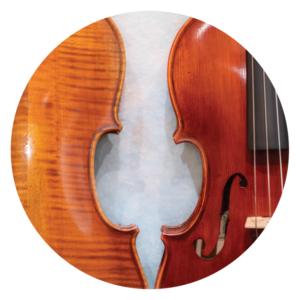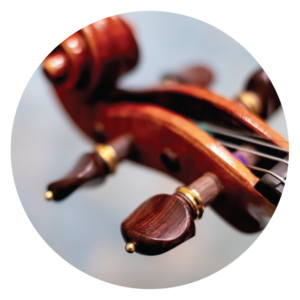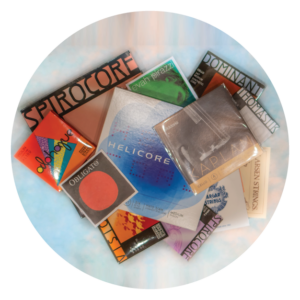Stepping Up the
VIOLIN
Stepping Up
the VIOLIN
After playing the violin for a few years, a beginning player often upgrades parts of their instrument, like the strings or bow. This initially helps them improve the sound from their student-level instrument. However, if the student has already done this, is taking private lessons, or playing more advanced music, it may be time to upgrade the entire instrument to a performance-quality, or “step-up,” violin. Step-up violins are specifically handcrafted to improve the tone, response, and projection. The upgraded wood, along with a longer aging process, helps create more stability from temperature and humidity changes. The better tonewood also helps to create a richer tone quality. Internal carving helps to improve resonance and fine-tunes the response of the instrument. More delicate varnishes allow the sound to project better. Customized finish options make it possible to tailor both the look and sound of the violin to the player’s liking.
Upgraded Wood

Customized Features

Strings

Varnish

Characteristics to Consider
Upgraded Wood: Wood is the most important aspect of the instrument. It must be cut, stored, and aged properly to make the best sounding instruments. Violin makers prefer wood that comes from the higher altitudes and cooler climates. That makes harder, stronger wood. Spruce is used on the front or top of the instrument, and maple or poplar is used on the sides and back of the instrument. Ideally, wood is aged for at least 7 years. Some wood is aged 50 plus years before it becomes a violin!
Customized Features: Once the instrument is handcrafted and glued together, then fittings are chosen. Fingerboards are made of Ebony wood. This is the most stable wood and most resistant to climate changes. Pegs and tailpiece are often made with ebony, boxwood, or rosewood. Boxwood and rosewood make for different aesthetic looks. All function well. Tailpieces can vary beyond different woods; composite materials can be used as well to make the instrument lighter, allowing for more sound production. Fine tuners can be built into the tailpiece or added to a wood tailpiece. Chin rests can also be changed. Not all body types fit the same chin rest. There is an assortment of styles to help make playing comfortable for all players.
Strings: Step-up violins are strung with better quality strings. Most often violinists will use a synthetic core string. This is the closest man-made material that sounds like gut strings without the large price tag and much more durable than a gut string. There are many brands available on the market.
Varnish: There are 2 main types of varnishes, spirit, and oil. Spirit varnishes are made using resins (tree sap) and alcohol or turpentine. Spirit varnishes dry quickly but are more difficult to apply. Oil varnishes are made with linseed or walnut oil and other ingredients and are much easier to apply, however, take much longer to dry. These varnishes are more delicate than the varnish on student instruments. Spirit and oil varnishes allow the sound to come out of the instrument and project more easily, showing off the instrument’s tonal richness.
It is important to consider these features when choosing an upgraded violin, but the best way to decide is to come in and try out these upgraded models for yourself. At Menchey Orchestral String Gallery, we have a great selection of upgraded violins from Eastman, Shen, and many more. One is sure to be the perfect match for you!
Contact Us About Upgrading Your Orchestra Instrument
Menchey Orchestral String Gallery
1185 High Street
Hanover, PA 17331
Sandy Neill, String Specialist
Phone: 888-636-2439 x 236 or
email Sandy.